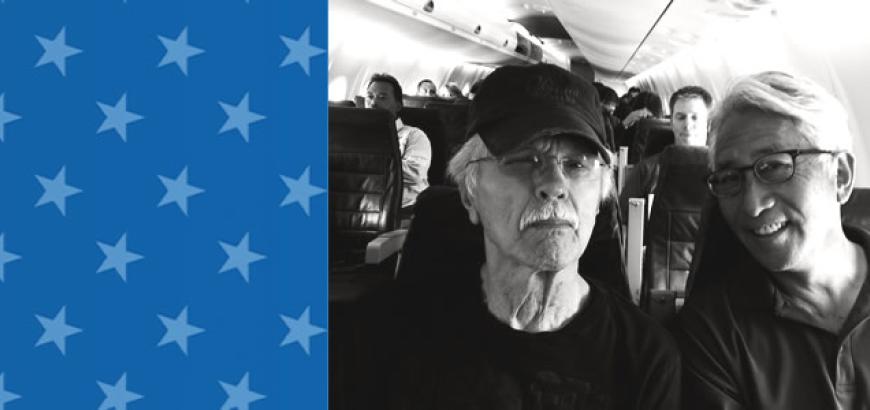In the early 70s when I first started teaching, young Vietnam veterans were just starting to come back to college and were enrolling in my English classes. We were the same age—midtwenties. I wasn’t drafted because I had a high lottery number. When they came back, I wanted to know their story, particularly the Asian American soldier sent to fight an Asian war. I interviewed and recorded the oral histories of many veterans and though we were peers, I always felt that there was a huge gulf between us. I stayed in college and they left. I could tell then that the person who came home wasn’t the same person who left.
In the summer of 2014, I was teaching a storytelling workshop in Walla Walla to fifteen Vietnam veterans as part of The Red Badge Project, co-founded by actor and Seattle resident Tom Skerritt and retired Army Captain Evan Bailey, a veteran of both the Iraq and Afghanistan wars. For the previous two years we had been teaching storytelling workshops at Joint Base Lewis-McChord in the WarriorTransition Battalion (now taught at the UW Tacoma campus), along with instructors Warren Etheredge, Brian McDonald from The Film School in Seattle and retired Navy combat photographer and former Clinton White House photographer Johnny Bivera. Skerritt had called all of us because he had read that the numbers of soldiers and veterans committing suicide was
higher than the number dying in combat in Iraq or Afghanistan. One cause seemed to be the inability to articulate their story while struggling with Post Traumatic Stress Disorder (PTSD).Skerritt put together a team of storytellers.
In that first class two years ago, none of my students would make eye contact with me the first day of class. They looked down at their laptop screens or mobile phones or just looked down at their desks. Two brought large German Shepard anxiety service dogs. When I entered the classroom that first day, one of the dogs came bounding up to me and leapt up and placed his front paws on my shoulders and backed me up against the wall, face to face. I found out later that these service dogs were trained to react this way or lean their weight against you when they sensed your elevated anxiety. I was anxious and perhaps more so with a 160 pound German Shepard in my face. I had been told that some of my students might be diagnosed with paranoid schizophrenia, delusion, and/or PTSD. Many would be recuperating from surgery, managing pain and most were angry. Loud noises made them grip the edges of their desks. My job was to teach them how to tell a story.
Skerritt brought an excerpt from the screenplay for the movie Sideways, for the students to read and act out. I had my doubts. But, the script was a great ice-breaker. Everyone laughed at the obviously flawed performances and men having to play female roles. Skerritt deftly directed each scene where soldiers
dressed in camouflage mimicked drinking pinot noir and talked about relationship strategies. By the third day, the soldiers were making eye contact; one left her anxiety dog at home. By the fifth day, another soldier arranged a picnic lunch for everyone. Stories emerged not about combat or being in the Army, but about family, growing up, friendship or the next life after the Army.
That was how it started in 2012. We structured our classes to run for three hours a day for three weeks, then start a new class. What we didn’t plan for was that, along with new students, the soldiers who had completed the course would sign up for the class again, and again, and again, and so on until they were discharged from the Army. One soldier who took the class five times said that the class saved his life. Many said it was better than therapy—it was therapeutic but not therapy. Evan Bailey explained our concept as one teacher explains why we need to tell stories, the next teacher tells us how and finally, the last teacher makes us write it down. I’m the last one.
As a professor at the University of Washington, a publicinstitution, it’s essential that part of my job is to be a public scholar and to engage the community in a conversation about who we are. After forty-two years of teaching (thirty at the UW), it was time for me to get out of the classroom and go on the road and find students who have something to say. They’re not always going to come to me.
Back in Walla Walla, I realized I was facing essentially the same veterans I had in my class forty years ago. We were all older now, all of us in our 60s now. I asked the vets in front of me to write a description of any photograph from memory that they were in. One of them wrote a description of his platoon in Vietnam sitting at their base drinking coffee—the relaxed moment between combat missions. I didn’t ask him why he chose that photo, but I could tell there was a story. I wanted to get to the edge of the story, but not to the story itself. Let’s just look at it as if it were a photo. Eventually we’ll get to tell that story.
